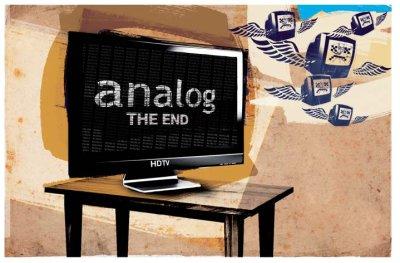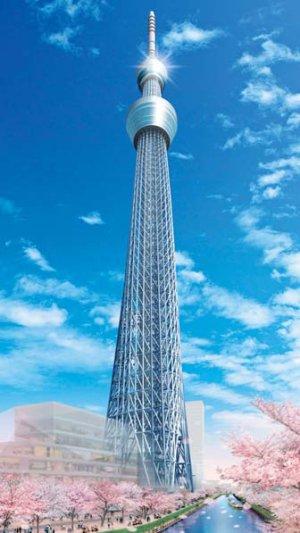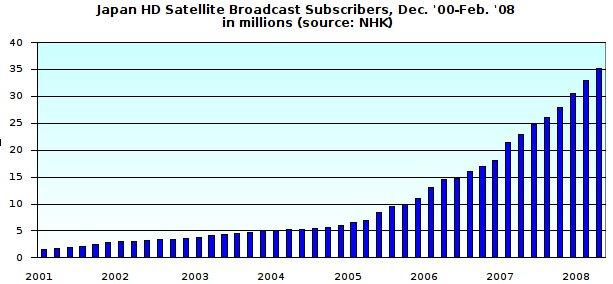Japan Redefines the World

By Brad Frischkorn
Long the global leader in high-definition television (HDTV), Japan will finally see a rival when the US formally switches over from analog to digital broadcasting next February. While rough technological parity between the world’s two largest economies promises benefits for market players and viewers alike going forward, it could be just a taste of what lies around the corner.
Ahead of the curve
Those taking refuge watching TV indoors during the sweltering heat of summer may take some solace in knowing, in Japan, no other public broadcasting system compares in terms of picture quality. The reasons are simple enough: it’s been in the works here for over 40 years, lavishly subsidized by the state, and deftly maneuvered through technical, bureaucratic, and political minefields until Japan’s “Hi-Vision” specs finally received the blessing of the International Telecommunications Union (ITU) as the global studio standard in 2000. The far-sighted vision for Hi- Vision took shape at the state-owned Nippon Housou Kyoku (NHK) in 1964, notably the same year Tokyo hosted the summer Games of the XVIII Olympiad, and unveiled the world’s first high-speed bullet train service. Much has been written about Japan’s phoenix- like ascent from the ashes of World War II, but the success of HDTV may deserve note as a monumental victory all by itself.
Japan certainly did not invent HDTV single- handedly; as defined by lines of resolution (the more the better), TV has been improving since the earliest British 405-line black-and-white systems of the 1930s. The current 525-line US standard transmission system (NTSC) was established in 1941, while the 625-line PAL and SECAM systems used in Europe sprang up in the post-war period. HDTV easily trumps the competition with 1,080 lines, however, and the further migration to digital from analog signal allows for higher quality images and sound and more programming choices. Hi-Vision’s 16:9 aspect ratio standard is the same format seen in movie theaters, and its range of frame and field rates (1920x1080i and 1280x720p) are now almost universally accepted—this means that viewers can enjoy cinema level picture quality from their living room armchairs. Sound quality has also been standardized with adoption of the 5.1 channel being standard.
 Riyo Mori, Miss Universe 2007 (courtesy NAB)
Riyo Mori, Miss Universe 2007 (courtesy NAB)
The significance of the switchover from analog to digital in the US could not be further underscored; at the National Association of Broadcasters (NAB) Conference held in Las Vegas last April (the industry’s annual Mecca event) 100,000 industry veterans from around the globe (including over 5,000 from Japan) showed up to check out the latest HD gear. In his keynote address, NAB President and CEO David Rehr said the transition is his organization’s highest television priority.
Betting the farm
Japanese broadcast equipment maker Sony is so committed to HDTV that it chose the NAB event to announce the launch of 25 separate product models, and even brought in newly crowned Miss Universe Riyo Mori to help parade them in front of crowds. “HD technology is taking hold in every aspect of video productions, and not just for traditional broadcast applications,” says Alec Shapiro, a senior Sony USA official, pointing out strong sales to arts and entertainment venues, sporting events, concerts, and movie theaters.
Whereas HDTV wasn’t even introduced in the US until the 1990s and most of Europe outside the UK has yet to reach a consensus on technical specifications, Japan’s long-term investment in HDTV has given domestic firms a huge head start in developing gear for the global rollout, despite some setbacks with the early MUSE system. Since then Sony, along with JVC, Canon, and Panasonic et al have captured huge swathes of the market for HDTV cameras and recorders, while Samsung of South Korea and Japan’s Sharp together are gunning for a staggering 50% of the exploding global market for LCD TVs by 2011. Consumers have benefited from savage competition among manufacturers, as prices for LCD and plasma flat panel displays have tumbled as much as 70% over the last five years.
“The public and private sector cooperation has been such that ordinary Japanese people don’t necessarily think of HDTV as anything special,” says NHK engineer Kenji Terada, noting that 93% of Japanese households already receive HDTV broadcast signals, thanks mainly to the country’s BS satellite service (BS-hi), which came online in 2000. The One-Seg system for mobile receivers (cell phones and car navigation systems, and so on) has been up since 2006.
 Tokyo Sky Tree, artist's conception (courtesy Tobu Railway, Tobu Tower Sky Tree Corp.)
Tokyo Sky Tree, artist's conception (courtesy Tobu Railway, Tobu Tower Sky Tree Corp.)
“In Europe, the focus for digital seems to be on increasing the number of channels, but the hi-def movement is alive. Hosts of the 2006 FIFA World Cup held in Germany put all of the games in a special PAL wide 16:9 aspect ratio format for international broadcasts, essentially mimicking HD,” continues Mr Terada. In the US, major broadcast networks CBS, NBC, PBS, and CNN—along with most of the documentary cable channels—have all standardized on the 1080i benchmark. Ironically, however, with just a few months to go before the digital TV transition, 36% of respondents to a recent nationwide Consumer Reports survey said they were “completely unaware” any such changeover is coming.
Japan’s switch to digital has not come cheaply; almost ¥4 trillion in state money has been earmarked for the public to receive HDTV signals. And for the fraction of homes that are left behind (about 7%) 2,000 ground stations will be built to ensure blanket coverage by the time analog broadcasts formally cease in three years. Almost 100% of the funds for this massive undertaking will come from payments collected directly from NHK viewers themselves. The Tokyo Sky Tree, a new 610-meter broadcast tower currently under construction in Sumida Ward, is also part of the budget. In competition with the 50-year old landmark Tokyo Tower in Roppongi, it will stand as the world’s tallest structure upon completion in 2011. Viewers will see some of Japan’s investment in HDTV on display at the upcoming 2008 Beijing Olympics, the first to feature complete high-definition event coverage.
Content and services lead the way
Now that global broadcasting standards issues have been largely settled, content and services will naturally follow, driving a buildout that will continue for years. The picture is far more dynamic abroad, where companies and whole markets are springing up in a frantic effort to fill in projected demand for HD-related material.  Tom Fratts, CEO of RioVista Productions.In this regard, cyberspace will play a vital role, many say. “Broadcast networks and the Internet’s streaming media systems are standardizing on HD content, and acquisition for this content is expanding very quickly due to the implementation of low-cost and efficient mobile broadcast systems,” explains Tom Fratts, CEO of RioVista Productions, a San Diego video startup firm. “Simply put, Internet streaming channels are now third partners to traditional broadcasters and film producers—and there seems to be no limit to the type and scope of emerging material.”
Tom Fratts, CEO of RioVista Productions.In this regard, cyberspace will play a vital role, many say. “Broadcast networks and the Internet’s streaming media systems are standardizing on HD content, and acquisition for this content is expanding very quickly due to the implementation of low-cost and efficient mobile broadcast systems,” explains Tom Fratts, CEO of RioVista Productions, a San Diego video startup firm. “Simply put, Internet streaming channels are now third partners to traditional broadcasters and film producers—and there seems to be no limit to the type and scope of emerging material.”
Internet Protocol TV (IPTV) and Voice over Internet Protocol (VoIP) software, in which video and audio streams are encoded in a series of discrete packets before being received and assembled in a lag-free form, is being pushed strongly by telecom companies abroad that want to become the sole communications link to the home (cashing in on the so-called “triple play” of telephone, TV, and Internet/data delivery). Video on Demand (VoD), which features DVD-style control over streamed video programs, is a further refinement of IPTV.
Separately, satellite broadcasting is also entering an unprecedented boom phase as over 1,000 new channels are added by satellite- TV platforms each year, according to research firm Euroconsult. It projects a record 180 million subscribers globally by 2017.

In Japan, the availability of 2.5G, 3G, iMode, and HSPA handsets have already given consumers acceptable mobile connection speeds for music, TV and gaming. Japan actually leads the legal content revenue market in the Asia Pacific region. IPTV International, a trade industry publication, predicts that Japan, South Korea and Hong Kong will soon lead all of Asia to compete with Europe as the dominating force in the global IPTV market. “The need for specialized content will grow significantly because the number of channels is growing exponentially,” says one US industry expert. “In order to compete, content producers must now be prepared to provide HD media in the multiple-formats that meet all of these varied delivery options.”
UHTV: The Next Wave
As if the revolution to HDTV were not enough, the next frontier is already a reality: Ultra High-definition TV (UHTV), which Japan is again at the forefront in developing. First shown in 2003, it awed packed crowds in Las Vegas at the NAB show last April. UHTV’s 4,000 lines of resolution (16 times more refined than HDTV) and 22.2 multi-channel sound system provides a jaw-dropping media experience so realistic that cases of motion sickness among viewers have been reported in some tests.
For the time being, scarce memory and bandwidth will keep a lid on applications for UHTV; a typical 20-minute video can devour up to 800 DVDs of storage space (4TB), and requires connection speeds thousands of times faster than what is now available. Emboldened by their success with HDTV however, NHK engineers are not put off by the challenges. “It shouldn’t take as long for UHTV as it did for HDTV to reach the public—certainly not 40 years,” predicts NHK’s Terada. “We’re hoping to get something out there by 2015, so the future is not that far off.” JI





